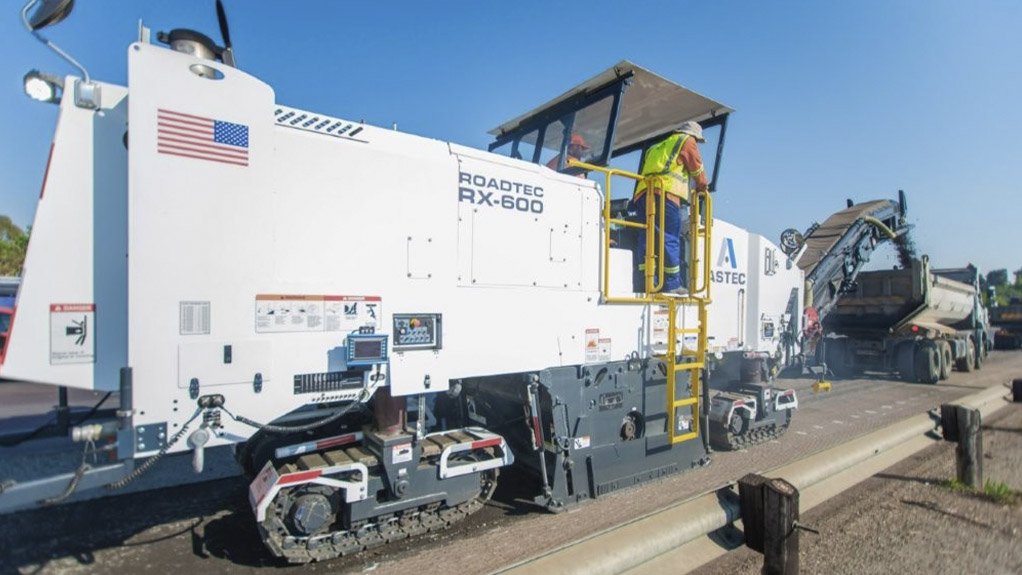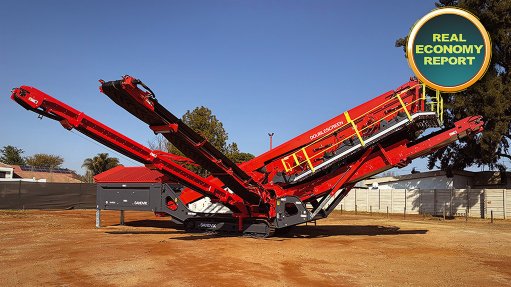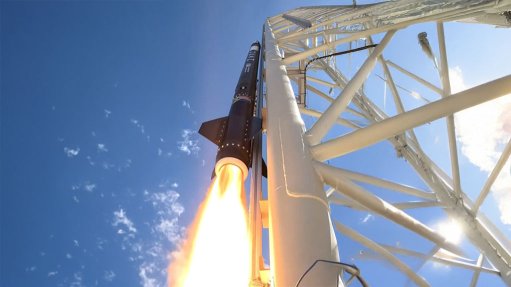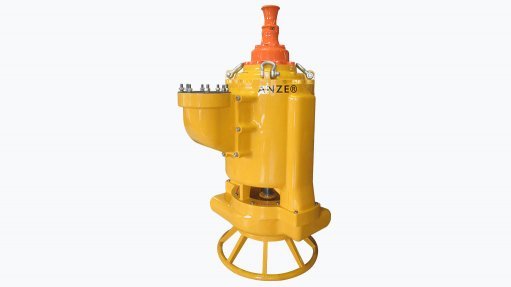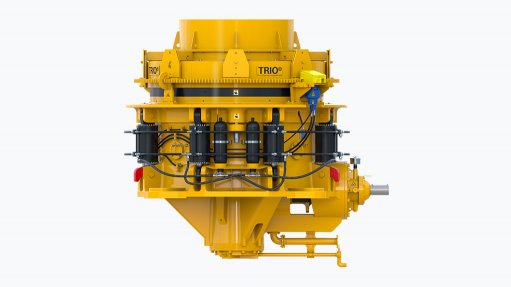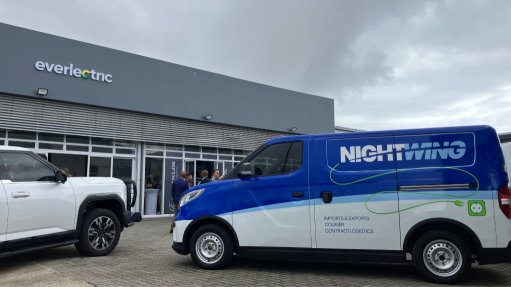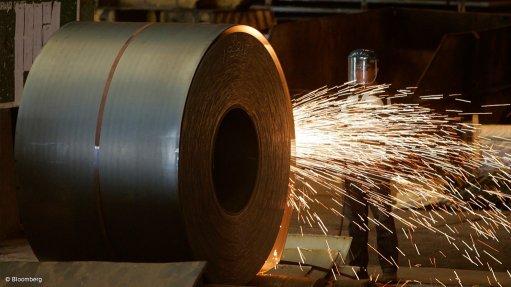Transport Month 2025: Quality Astec equipment at the heart of South Africa’s infrastructure success and economic growth
This article has been supplied and will be available for a limited time only on this website.
Advanced Astec machines are setting new standards in road construction and rehabilitation, ensuring smooth, uniform roadways that last longer, while the manufacturer’s materials handling equipment is streamlining port and rail loading operations. “Using the right equipment for the project ensures efficiency, safety and sustainability in the transport sector - all of which are critical enablers of economic growth,” Astec states.
“Whether it's an asphalt milling machine preparing roads for resurfacing or a material transfer vehicle ensuring uninterrupted asphalt delivery, our road building equipment helps engineers and construction teams build a better-connected South Africa,” says Philip Saunders, product sales manager for Astec’s Materials and Infrastructure Solutions divisions.
Improving road surface quality
“As government departments and private contractors work to expand and maintain South Africa’s road network, Astec is contributing to projects’ success and road surface quality by supplying critical road-building equipment like the Astec SB-3000, one of the most advanced Shuttle Buggies on the market,” he expands.
The Shuttle Buggy is a Material Transfer Vehicle (MTV), which was a novel concept when Astec Roadtec introduced its first Shuttle Buggy in 1989. Before this, road surface failure due to asphalt segregation was a recurring problem. Before the Shuttle Buggy’s introduction, hot mix asphalt (HMA) was dumped directly from trucks into pavers, which often led to problems. During transport from the asphalt plant to the jobsite, mixes would segregate both thermally and physically. Thermal segregation occurs when different portions of the mix cool at uneven rates, with exposed material at the edges of truckloads or on the surface cooling far more quickly than the core. Physical segregation occurs when coarse aggregates separate from finer materials during handling, loading or dumping, which results in inconsistent pockets of mix. Left unchecked, both forms of segregation weaken bonds in the mat, reduce compaction and ultimately lead to uneven surface quality and premature pavement failure.
Engineers realised that being able to re-mix the HMA before feeding it to the paver was the key to increasing road surface quality - achieving uniform density, durability and long-lasting performance. The Shuttle Buggy not only reblends material but also transforms the paving process itself: it allows paving teams to operate continuously, eliminating the stop–start interruptions that occur when trucks unload directly into the paver. In addition, because the Shuttle Buggy feeds material without the truck ever making direct contact with the paver, the process is fully contactless, reducing wear on the paver, improving consistency and pavement smoothness, and enhancing overall safety on site and for the road users themselves.
“The Shuttle Buggy’s ability to save time and costs while improving road quality has made it a crucial piece of equipment on road construction, maintenance and rehabilitation projects around the world. This is why an Astec SB-3000 was deployed to enhance roadworks on the N2 at George in the Western Cape,” Saunders reveals, adding that Astec was delighted to have had the opportunity to supply the unit to support its customer on this road rehabilitation project.
He says that this proven performance is also the reason the Shuttle Buggy was the original Material Transfer Vehicle written into SANRAL’s road surfacing requirements and remains so, recognising the machine’s inherent benefits in eliminating segregation, enabling continuous and contactless paving, improving mat quality, and extending pavement life.
Rehabilitating the R21 highway
A durable, powerful, high performance Astec machine that made its debut in South Africa on the rehabilitation of the R21 highway in Gauteng is the RX-600ex cold planer.
Cold planing, also known as asphalt milling, is the removal or milling up of an existing asphalt surface to provide a smooth, uniform base for resurfacing. It ensures smooth and uniform roadways. Saunders notes that in addition to motorway rehabilitation and milling, the RX-600ex’s applications include urban road projects. Its lighter weight and versatility ensure manoeuvrability in urban locations. It is also suitable for lane profiling and maintenance.
Astec also supplied and commissioned the first Astec cold planer to be used on the important N5 corridor maintenance and rehabilitation project in the Free State. “We are proud to be contributing to SANRAL’s critical national infrastructure improvements after supplying an Astec RX-600ex 2.0m Cold Milling Machine to a leading contractor, for use on the roadworks between Bethlehem and Harrismith,” says Saunders.
He explains that this is the first deployment of an Astec RX-600ex cold planer in this part of South Africa. “The high visibility of the site and the often-heavy traffic volumes on the N5 corridor demand precision milling, speed, efficiency and uncompromising safety. The Astec RX-600ex has got what it takes to exceed expectations.”
Stabilising South Africa’s Roads
Another high-performance machine making a growing impact in the South African market is the Astec SX-6ex Soil Stabiliser/Reclaimer.
The SX-6ex combines power, balance and versatility to help contractors tackle some of the most demanding road rehabilitation tasks. Its design is centred on improving productivity and output while ensuring a consistent, high-quality result. The machine’s variable geometry cutter housing and 8-cutter drum speeds give operators more control over material gradation - whether the goal is breaking down hard soils, blending stabilising agents, or achieving a more uniform gradation for strength and durability. Because the cutter housing is bolted directly to the machine’s mainframe, the SX-6ex can cut in both directions - forward and reverse. In practice, this allows operators to “work” material multiple times in place when conditions require it, such as loosening and re-blending to improve gradation or refine the quality of the final layer. Instead of having to make multiple passes in one direction or re-set the machine, the SX-6ex can efficiently reprocess material on the spot, saving time while achieving better product consistency.
Operator-focused features also play a role in raising output. The cab can slide out to give a clear view of the cutter edge, improving precision. Quick-change tooling reduces downtime for maintenance. Balanced weight distribution and four steering modes give the machine agility and control across varied terrain. All of these translate into higher daily production and greater reliability in challenging conditions.
“The SX-6ex is proving itself to be an indispensable machine for contractors. With its productivity, quick-change tooling and efficient power distribution, it provides reliability on some of the toughest jobsites,” Saunders highlights. The SX-6ex is currently on rental through Astec’s rental partner to a notable contractor in the South African roads and civils industry. The unit is being cycled across three key projects, two in the Free State Province and another in Gauteng, where it continues to demonstrate its versatility, durability and value to large-scale road improvement projects.
Revolutionising port and rail loading operations
South Africa’s ports are gateways to international trade, and reliable handling equipment ensures that goods flow swiftly and safely through these critical nodes. Innovative equipment from Astec Industries is revolutionising the way that port-based companies handle their materials. Machines like the Astec Telestack TB52 telescopic boom ship loader and the Astec Telestack HF523 “Revolution” tracked hopper feeder are enabling logistics operators to save time, money and fuel, while increasing production rates.
Astec Industries regional product and sales manager Andre Kruger says that Astec Telestack equipment delivers enhanced flexibility and efficiency in handling dry bulk material, whether from the pit, the port or plant. “Telestack’s ‘All Wheel Travel’ (AWT) technology is one of the most exciting developments in the bulk handling industry in recent years and promises to transform ship loading. The use of mobile systems at ports and inland terminals is expanding globally.”
The Astec Telestack HF823, which is part of the manufacturer’s Revolution series, is ideal for barge loading and unloading, rail wagon loading and unloading and stockpiling. The ability to move parallel enables the operator to manoeuvre the unit parallel to the vessel or wagon, removing the need to reposition when loading or unloading the ship. This translates into significantly improved loading rates and efficiency, Kruger explains.
Also delivering big benefits at ports around the world, the Astec Telestack TB telescopic boom ship loader is designed, manufactured and built with the customer’s specific requirements in mind. Kruger says that its mobility offers exceptional flexibility when handling dry bulk. “Other important considerations are that there is no civil construction needed and no planning permissions required to deploy the TB52. The capital expenditure is lower than that needed for fixed infrastructure and mobile harbour cranes. There are environmental advantages, too, since this unit features integrated dust extraction and containment systems. It is a multi-function machine that can be used for ship loading and unloading, for stacking, stockyard management and reclaiming.
“Transport Month is significant for Astec Industries because connection is at the heart of everything we do,” Kruger says. “We design and manufacture products used to build the infrastructure that physically connects the world. Our Astec tagline says it all: we are ‘Built to Connect’.”
Comments
Press Office
Announcements
What's On
Subscribe to improve your user experience...
Option 1 (equivalent of R125 a month):
Receive a weekly copy of Creamer Media's Engineering News & Mining Weekly magazine
(print copy for those in South Africa and e-magazine for those outside of South Africa)
Receive daily email newsletters
Access to full search results
Access archive of magazine back copies
Access to Projects in Progress
Access to ONE Research Report of your choice in PDF format
Option 2 (equivalent of R375 a month):
All benefits from Option 1
PLUS
Access to Creamer Media's Research Channel Africa for ALL Research Reports, in PDF format, on various industrial and mining sectors
including Electricity; Water; Energy Transition; Hydrogen; Roads, Rail and Ports; Coal; Gold; Platinum; Battery Metals; etc.
Already a subscriber?
Forgotten your password?
Receive weekly copy of Creamer Media's Engineering News & Mining Weekly magazine (print copy for those in South Africa and e-magazine for those outside of South Africa)
➕
Recieve daily email newsletters
➕
Access to full search results
➕
Access archive of magazine back copies
➕
Access to Projects in Progress
➕
Access to ONE Research Report of your choice in PDF format
RESEARCH CHANNEL AFRICA
R4500 (equivalent of R375 a month)
SUBSCRIBEAll benefits from Option 1
➕
Access to Creamer Media's Research Channel Africa for ALL Research Reports on various industrial and mining sectors, in PDF format, including on:
Electricity
➕
Water
➕
Energy Transition
➕
Hydrogen
➕
Roads, Rail and Ports
➕
Coal
➕
Gold
➕
Platinum
➕
Battery Metals
➕
etc.
Receive all benefits from Option 1 or Option 2 delivered to numerous people at your company
➕
Multiple User names and Passwords for simultaneous log-ins
➕
Intranet integration access to all in your organisation



